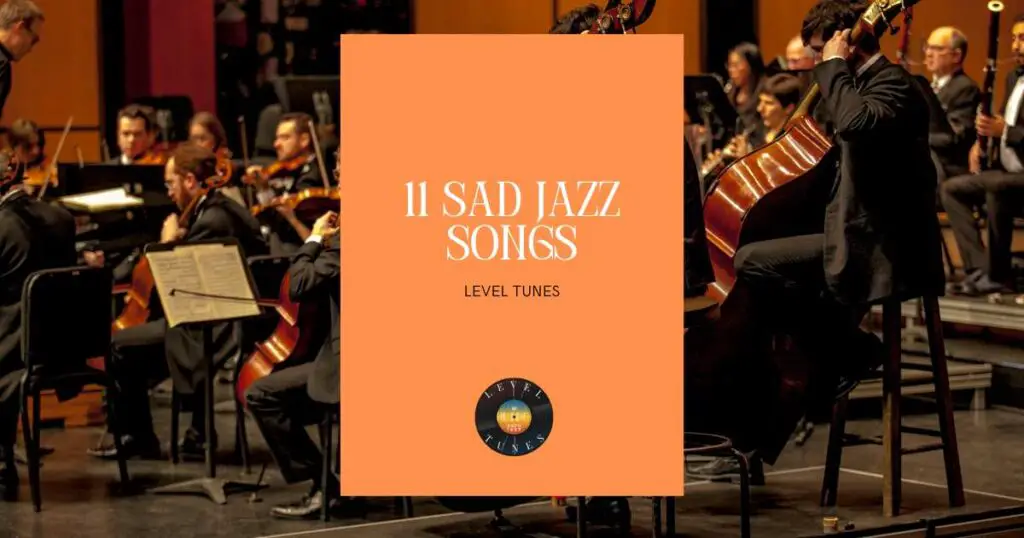11 Sad Jazz Songs: Tracks That Touch the Soul
Hey there, fellow music aficionados! It’s TBone here, the heart and soul behind Level Tunes.
With over 20 years of spinning tracks and immersing myself in the boundless world of music, I’ve developed a deep-seated love for all things jazz. It’s not just a genre to me; it’s a way of life. That’s why I’ve decided to share with you a list of 11 sad jazz songs that have touched my heart over the years.
These tracks are more than just melodies; they’re stories of love, loss, and longing that resonate on a universal level.
As a DJ and a devout music lover, I’ve curated this list to not only showcase the emotional depth of jazz but also to connect with you, my fellow music lovers, on a more intimate level. Let’s dive into the soulful world of jazz together and explore the melodies that make us feel deeply.
Here are the Sad Jazz songs that you can check out:
List Of Sad Jazz Songs
Sad Jazz songs in a list format:
“Goodbye Pork Pie Hat” – Charles Mingus
From the album “Mingus Ah Um,” released in 1959 under Columbia Records, “Goodbye Pork Pie Hat” stands as a monumental piece in the jazz world. Charles Mingus composed this elegy in memory of the legendary saxophonist Lester Young, who was known for his distinctive pork pie hat. This song is a rich tapestry of emotion, blending sorrow with a deep respect for Young’s legacy. What strikes me every time is the profound melancholy that Mingus conveys through his bass, coupled with the haunting saxophone lines that seem to echo Young’s voice. The piece is not just a composition; it’s a heartfelt goodbye, a musical tribute that speaks volumes of Mingus’s genius and his ability to convey deep emotions through jazz. The ensemble’s performance is stellar, making it a must-listen for anyone who wants to feel the soul of jazz.
“Round Midnight” – Thelonious Monk
Thelonious Monk’s “Round Midnight” is arguably one of the most poignant pieces in the jazz repertoire. Found on the album “Genius of Modern Music: Volume 1,” released in 1952 by Blue Note Records, this composition showcases Monk’s innovative approach to harmony and rhythm. What makes “Round Midnight” so captivating is its introspective mood and the way it encapsulates the essence of loneliness and contemplation that comes after dark. Monk’s piano playing is both intricate and emotional, drawing listeners into a nocturnal world of introspection. The song has been covered by many great musicians, but Monk’s original version has a rawness and vulnerability that remain unmatched. It’s the complexity and the emotional depth of Monk’s composition and performance that have always resonated with me, making it a timeless piece in my collection.
“I Loves You, Porgy” – Billie Holiday
Billie Holiday’s rendition of “I Loves You, Porgy,” from her album “The Ultimate Collection,” released in 1958 by Verve Records, is nothing short of haunting. This song, originally from George Gershwin’s opera “Porgy and Bess,” is transformed under Holiday’s spellbinding vocals into a deep, sorrowful lament. Her voice, laden with emotion, conveys a profound sense of longing and despair that is palpable. Holiday’s ability to express the weight of the lyrics while maintaining a delicate control over her vocal nuances is what makes this performance unforgettable. Each note she sings carries the burden of the characters’ tragic love story, making it a deeply moving experience for the listener. It’s Holiday’s emotional delivery and the song’s tragic context that have always made this piece stand out for me.
“Blue in Green” – Miles Davis
Featured on the groundbreaking album “Kind of Blue,” released in 1959 under Columbia Records, “Blue in Green” is a masterpiece of modal jazz that Miles Davis brought to life. This song is a profound exploration of melancholy and introspection, with Davis’s trumpet lines weaving through Bill Evans’s delicate piano chords in a dance of shadow and light. The interplay between the musicians creates a haunting atmosphere that envelops the listener in a sense of profound sadness and beauty. What I admire most about “Blue in Green” is its ability to convey complex emotions with such simplicity and depth. The song feels like a quiet, introspective journey into the soul, making it a quintessential piece for those reflective, introspective moments. Davis’s ability to create such a timeless piece speaks volumes of his genius and sensitivity as a musician.
“Strange Fruit” – Billie Holiday
Billie Holiday’s “Strange Fruit,” released in 1939 by Commodore Records, is a powerful and heart-wrenching song that tackles the brutal reality of racism and lynching in America. The haunting imagery of the lyrics, combined with Holiday’s soul-piercing vocals, creates a chilling condemnation of racial violence. This song goes beyond sadness; it’s a poignant cry for justice and a historical document of the dark side of American history. What always strikes me about “Strange Fruit” is Holiday’s courage to perform such a politically charged song during a time when speaking out came with great personal risk. Her emotional delivery and the song’s stark message make it a landmark recording in the history of jazz and civil rights. It’s Holiday’s bravery and the song’s haunting beauty that have made it an essential and powerful piece in the world of music.
“Naima” – John Coltrane
John Coltrane’s “Naima” is a love ballad of ethereal beauty, featured on his album “Giant Steps,” released in 1960 by Atlantic Records. This composition stands out for its serene and tender melody, which Coltrane wrote in dedication to his then-wife, Naima. The gentle flow of the saxophone lines, supported by the soft, rhythmic undercurrent of the band, creates a dreamlike quality that is both soothing and melancholic. What
enchants me about “Naima” is Coltrane’s ability to express deep affection and yearning through his instrument, showcasing a different facet of his musical genius. The song is a testament to the power of jazz to convey profound emotional landscapes without a single word. The interplay between Coltrane’s saxophone and the rest of the quartet feels like a delicate dance of love and longing, making “Naima” a timeless piece that resonates with the heart’s deepest emotions. It’s the purity and depth of Coltrane’s expression that draws me back to this track time and again, reminding me of jazz’s capacity to touch the soul in the most tender ways.
“Lush Life” – John Coltrane and Johnny Hartman
“Lush Life,” performed by John Coltrane and Johnny Hartman on their 1963 album “John Coltrane and Johnny Hartman,” released by Impulse! Records, is a stunning exploration of melancholy and sophistication. This song, with lyrics and music by Billy Strayhorn, is given new life through Hartman’s velvety vocals and Coltrane’s emotive saxophone accompaniment. The collaboration between Hartman and Coltrane brings a depth and richness to the song, highlighting its themes of love, loss, and the weariness of life’s excesses. What captivates me about “Lush Life” is the sheer elegance of its execution, with Hartman’s voice and Coltrane’s saxophone melding together in a way that feels both heartbreaking and incredibly beautiful. The song is a masterpiece of emotional storytelling, showcasing the artists’ ability to convey complex feelings through their unparalleled musical synergy. “Lush Life” remains a profound reminder of jazz’s ability to articulate the nuances of human emotion.
“In a Sentimental Mood” – Duke Ellington and John Coltrane
The collaboration between Duke Ellington and John Coltrane on “In a Sentimental Mood,” from their 1963 album “Duke Ellington & John Coltrane,” released by Impulse! Records, is a landmark moment in jazz history. This song, with Ellington on piano and Coltrane on saxophone, is a deep dive into the realms of romance and reflection. The beauty of “In a Sentimental Mood” lies in the seamless integration of Ellington’s sophisticated piano harmonies with Coltrane’s expressive saxophone lines, creating a mood that is at once intimate and expansive. What draws me to this piece is the effortless dialogue between two giants of jazz, each bringing their unique voice to a conversation that feels both timeless and deeply personal. The track is a masterclass in musical empathy, showcasing the power of jazz to create spaces of emotional resonance and connection. It’s the song’s timeless quality and the legendary collaboration that make it an essential listen for anyone seeking to experience the soul of jazz.
“Body and Soul” – Coleman Hawkins
Coleman Hawkins’s rendition of “Body and Soul,” recorded in 1939 and released by Bluebird Records, is a seminal work that set the standard for tenor saxophone play in jazz. This song, a popular standard by Johnny Green, was transformed by Hawkins into a tour de force of emotional expression and technical mastery. Hawkins’s performance is a study in how to convey deep feelings without words, using his saxophone to articulate a range of emotions from longing to despair. What impresses me about “Body and Soul” is Hawkins’s innovative approach to improvisation, taking the listener on a journey that feels both deeply personal and universally relatable. The recording is a milestone in jazz history, marking a moment when the saxophone rose to prominence as a solo instrument capable of carrying the emotional weight of a piece. Hawkins’s “Body and Soul” is not just a song; it’s an emotional experience, a testament to the power of jazz to move and inspire.
“Alice in Wonderland” – Bill Evans
Bill Evans’s interpretation of “Alice in Wonderland,” from his live album “Sunday at the Village Vanguard,” released in 1961 by Riverside Records, showcases his lyrical and introspective approach to the piano. This song, a tune from the Disney movie adapted into a jazz standard, is imbued with a sense of wonder and melancholy under Evans’s touch. The way Evans explores the melody, with his signature harmonic richness and nuanced phrasing, turns the piece into a reflective, almost dreamlike meditation. What I find most captivating about Evans’s “Alice in Wonderland” is its ability to transport the listener to a space of introspection and beauty, highlighting Evans’s genius in transforming familiar melodies into profound jazz explorations. The track stands as a beautiful example of how jazz can reinterpret and deepen our connection to music we thought we knew, making it a standout piece in Evans’s illustrious career.
Fun Facts: Sad Jazz Songs
“Goodbye Pork Pie Hat” – Charles Mingus
One fun fact about “Goodbye Pork Pie Hat” is that Charles Mingus wrote this song as a tribute to Lester Young, a tenor saxophonist who was known for his distinctive pork pie hats. Young had passed away two months before Mingus recorded the track for his “Mingus Ah Um” album. Over the years, the piece has been covered by a wide range of artists across different genres, demonstrating its enduring appeal and versatility. Another interesting tidbit is that the song’s original title was “Theme for Lester Young,” but it was later changed to the more iconic “Goodbye Pork Pie Hat,” making it forever associated with Young’s signature style.
“Round Midnight” – Thelonious Monk
“Round Midnight” is widely considered Thelonious Monk’s most famous composition, and it holds the distinction of being the most recorded jazz standard composed by a jazz musician. The song’s complex harmonies and intricate melodies reflect Monk’s genius in composition. Interestingly, the song was first recorded by Cootie Williams, not Monk himself, which helped to popularize the tune before Monk had even released his own version. Another fun fact is that “Round Midnight” has appeared in numerous films and soundtracks, cementing its place in not just jazz history but also in popular culture.
“Strange Fruit” – Billie Holiday
“Strange Fruit” is one of the first songs to explicitly address racial violence in America, making it a significant cultural and political statement as much as a musical milestone. The song originated as a poem written by Abel Meeropol, a Jewish schoolteacher from the Bronx, who was moved by a photograph of a lynching. Billie Holiday’s courageous performance of the song at Café Society, New York City’s first integrated nightclub, introduced it to a wider audience, but it also led to significant personal and professional repercussions for Holiday due to its controversial subject matter. The recording was inducted into the Grammy Hall of Fame, acknowledging its profound impact on music and society.
“Blue in Green” – Miles Davis
A fascinating aspect of “Blue in Green” is the mystery surrounding its composition. While the song is credited to Miles Davis on the album “Kind of Blue,” pianist Bill Evans claimed in later interviews that he co-wrote the piece. This dispute over authorship has never been fully resolved, adding an intriguing layer to the song’s history. “Kind of Blue” is the best-selling jazz album of all time, and “Blue in Green” is a standout track that exemplifies the album’s innovative use of modal jazz, marking a departure from the more rigid structure of bebop that had dominated the genre.
“In a Sentimental Mood” – Duke Ellington and John Coltrane
The collaboration between Duke Ellington and John Coltrane for “In a Sentimental Mood” was a meeting of two generations of jazz greats, with Ellington being an established legend and Coltrane rising as a leading figure in modern jazz. What makes this collaboration unique is not just the bridging of different eras but also the mutual respect and admiration that both musicians had for each other, which is palpable in their recording. The session for their album was arranged quickly, and despite the spontaneity, the result was a timeless masterpiece. Ellington reportedly said that listening to Coltrane’s playing during their session was “like listening to a great singer”—a high compliment coming from a musician of Ellington’s stature.
And there you have it, friends—a journey through the heart and soul of jazz, exploring its depths through 11 of its most poignant songs. Each piece tells a story, painting emotions in the hues of sorrow and beauty. Thanks for joining me, TBone, on this musical exploration. Let’s keep the tunes spinning and our hearts open to the timeless stories jazz has to tell.
Thanks for reading.
TBone




